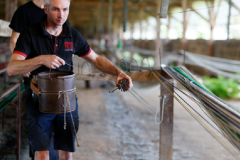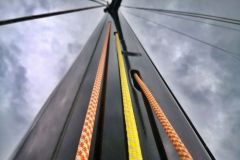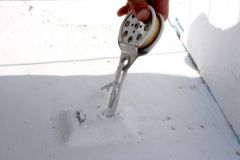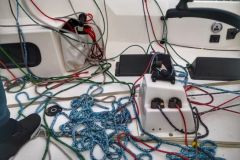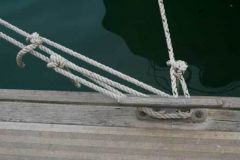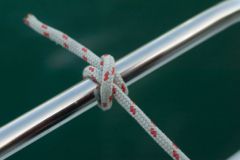Marlow, a rope manufacturer, offers a range of products suitable for cruising or regatta sailing. The range is composed of five references whose characteristics are detailed in the table below:
| Marlowbraid | Doublebraid | D2 Club | D2 Racing 78 | D2 Grand Prix 78 | |
| Soul | 3 polyester strands | 12 strands polyester | 12-strand Dyneema SK38 | 12-strand Dyneema SK78 | 12-strand Dyneema SK78 |
| Sheath | 16 polyester spindles | 24 polyester spindles | 16 polyester spindles | 24 polyester spindles | 24 spindles polyester/Technora |
| Available diameters | 6 to 24 mm | 6 to 18 mm | 8 to 14 mm | 8 to 18 mm | 8 to 18 mm |
| Weight in ø10 mm | 7.30 kg/100 m | 7.47 kg/100 m | 6.98 kg/100 m | 5.92 kg/100 m | 5.92 kg/100 m |
| Breaking load ø10 mm | 2850 kg | 3690 kg | 3,780 kg | 5360 kg | 5360 kg |
| Elongation at breaking load | 12 % | 12 % | 3,50 % | 3,50 % | 3,50 % |
| Price incl. VAT ø10 mm | 2.34 euros/m | 2.32 euros/m | 3.79 euros/m | 8.18 euros/m | 11.80 euros/m |
When changing ropes, whether halyards or sheets, it is advisable to follow a few rules by answering the following questions:
For what program?
What is the programme of the sailboat: the quiet cruise or the hard regatta?
On a cruising yacht, the ropes do not require too much rigidity. Indeed, if the rigging is already soft, if the sails are made of dacron (soft fabric), if the hull is not perfectly clean... putting a very stiff rope will be better, but will not bring much in terms of performance.
So naturally we will move towards a polyester rope for cruising (Doublebraid) and Dyneema for racing (D2 Racing 78).
What is my budget?
For the same diameter, a Dyneema rope costs 3.5 times the price of a polyester rope. This price difference makes many boaters think, "Do I really need a halyard with an extension of less than 3%?"
For the regatta, this point is less marked. All the more so as the search for weight leads to the smallest possible diameter. As a result, the price drops a little.
But when cruising, to protect the crew's hands and to offer comfort, the ropes are often larger in diameter and therefore more expensive..
Shall I start by changing the halyard or the sheet?
If you want to enjoy yourself, but you can't change all the manoeuvres, it's better to choose to fit out nice halyards rather than nice sheets.
Indeed, a halyard that gives back during its day's sailing is deplorable. Seeing unsightly folds appear in his mainsail or genoa is never pleasant for the sailor.
A halyard at least pre-stretched or better in Dyneema will hold the load much better and offer less stretch.
Polyester or Dyneema core?
Dyneema is a fibre with low elongation (3.5%), much less than polyester (12%). To fully understand these figures, it is important to understand that on a 10 m mast, a polyester main halyard will stretch 6 cm under load (we consider that we are working at 50% of the maximum load). In comparison, a Dyneema halyard will only give back 1.75 cm..
This is why the Dyneema is particularly popular on sailing boats. But although its qualities are interesting, its price is much higher than polyester..
There are several qualities of Dyneema. The least resistant, SK38 allows ropes to be made with the same resistance as polyester, but with a much lower elongation (the same elongation as SK78 is 3.5%). The SK78 is the most common Dyneema. Very expensive, the SK99 is only found on very sharp racing yachts.
How to ensure a good hold in blockers?
For a regatta racer, the blocking gear is of the utmost importance. Once the boulder is tightened, the block must be perfect, giving nothing back. Technora fibre has the best hold. In fact, it's the one used to make textile blockers. We could make a 100% Techora sheath, but this one would be rough, not pleasant to hold, less flexible. That's why Marlow combines Technora with polyester in the sheath of the D2 Grand Prix. And if you want a softer string, more comfortable to handle, he proposes the D2 Racing. For extreme use, you can also over-sheath with 100% Technora sheath the parts that come into the blocker!
Description of the Marlow range
Marlowbraid
It's a rope with a polyester core that's stranded. Already pre-stressed, it offers less elongation than Doublebraid. For the rest, its characteristics are identical. This is why it is recommended for halyards.
Doublebraid
It's the polyester all-purpose rope. This product range is more resistant than the competition because the Doublebraid is pre-stretched after manufacture. Thus, for the same diameter, the breaking load is one ton higher than the competition.
D2 Club
With its Dyneema SK38 core, the D2 Club gives cruising yachts access to Dyneema fibre. It has the same characteristics as polyester rope, but with 3 times less stretch. And for a price half the price of the D2 Racing in SK78 ..
D2 Racing 78
The Dyneema rope is the reference. It is used on all racing yachts.
D2 Grand Prix78
With 50% of its sheath in Technora, the D2 Grand Prix offers an astonishing hold in the blockers. A string reserved for the elite looking for the best (and who can afford it!).



